To effectively train oblique muscles at home, you must understand the biomechanics behind them so that you can easily modify the exercises according to your fitness level and requirements.
The oblique muscles consist of the external obliques and internal obliques. Both muscles contribute to trunk rotation, side bending, and core stability.
- The external obliques are superficial muscles located on the sides of the abdomen.
- The internal obliques lie beneath the external obliques, forming an X-shape.
These are top oblique exercises, with movements that target both muscle groups and can be done at home with minimal equipment.
Use Our Calculator To Know Your Body Fat Percentage
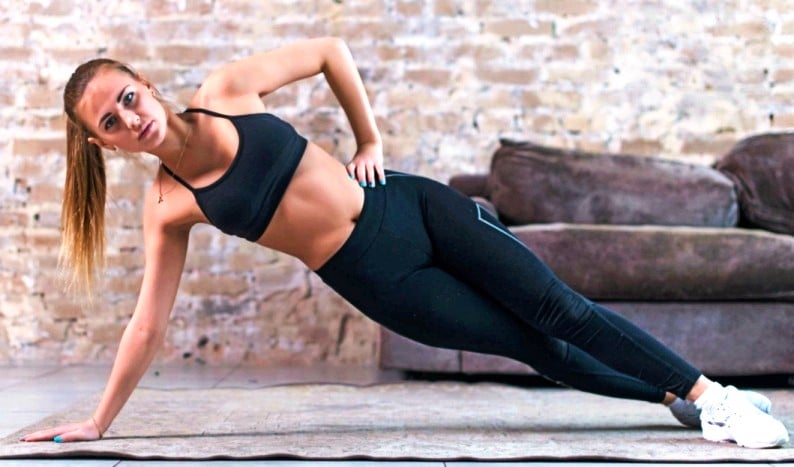
- At-Home Oblique Exercises
- 1. Standing Oblique Twist
- 2. Standing Side Crunch
- 3. Alternate Heel Touches
- 4. Side Plank
- 5. Russian Twist
- 6. Bicycle Crunch
- 7. Cross-Body Mountain Climber
- 8. Side Plank Hip Abduction
- 9. Oblique V-Up
- 10. Windshield Wipers
- FAQs
- Can oblique exercises help in reducing waist size?
- Do planks work obliques?
- Are obliques hard to build?
- Do obliques exercises thicken your waist?
- Are obliques like abs?
- References
At-Home Oblique Exercises
With these beginner-friendly exercises, you can build a strong foundation and improve your strength and endurance. As you become more comfortable with them, you can level up with intermediate oblique exercises.
1. Standing Oblique Twist
Standing obliques are a simple but effective exercise to train your obliques. When you perform this exercise, you’re also activating your shoulders, lower back, and hips.
This exercise helps improve rotational strength and stability.
If you are new to this, you can start with bodyweight and then slowly increase intensity by holding a dumbbell, medicine ball, or even a water bottle to increase resistance.
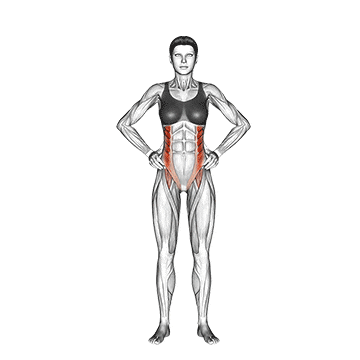
How To Do
- Stand with your feet hip-width apart and your knees slightly bent.
- Brace your core and begin to twist your upper body to the left side of your body, then the right.
- Keep your lower body still during the motion; only your torso moves.
- Repeat until all reps have been completed.
- Focus on the rotation coming from your torso rather than just swinging your arms.
2. Standing Side Crunch
The standing side crunches are the same as the regular oblique crunches, except that they are performed in standing position. It is a great way to tone your obliques and keep your body fit.
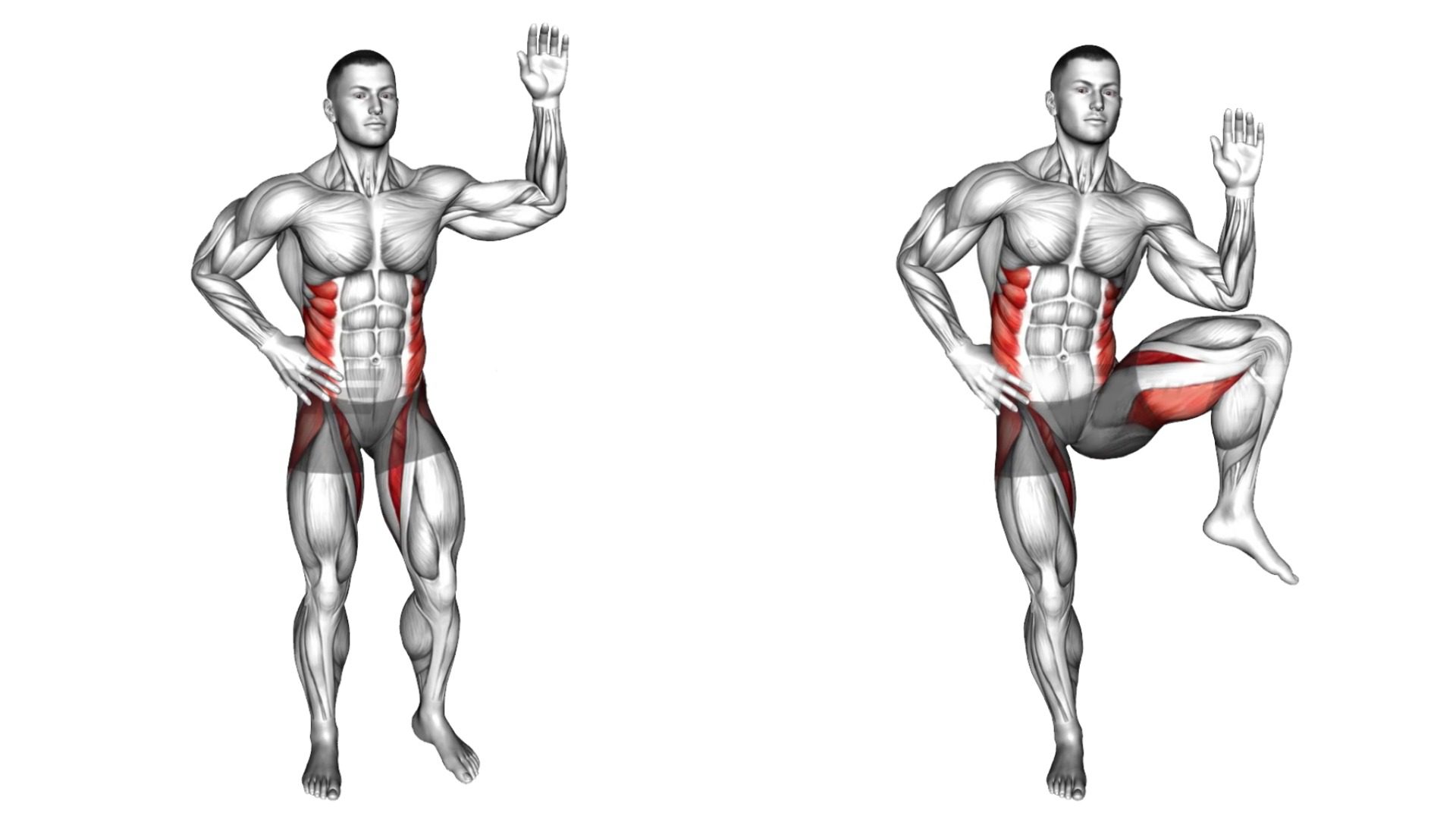
How To Do
- Get into a standing position with your knees slightly bent; your feet hip-width apart.
- Keep your chin tucked in throughout the movement.
- Then, crunch to the right side and bring your right knee up toward your elbow.
- Return to the starting position by lowering your right leg.
- Pause at the top of the movement for 2-3 seconds.
- Switch your legs and repeat until the set is over.
- Repeat the desired number of reps.
- You can start by doing 2-3 sets of 10–12 repetitions.
3. Alternate Heel Touches
Alternate heel touches, also known as lying oblique reach, are a home exercise that targets the oblique and abs muscles.
They also help improve flexibility and increases the range of motion in the hips.

How To Do
- Lie on your back with your knees bent and feet flat on the floor, hip-width apart.
- Place your arms by your sides, palms facing down.
- Engage your core muscles to stabilize your spine and maintain a neutral position.
- Lift your head, neck, and shoulders off the ground, keeping them elevated throughout the exercise.
- As you exhale, reach your right hand toward your right heel, feeling the contraction in your right oblique.
- Return to the starting position and repeat on the left side, reaching your left hand toward your left heel.
- Continue alternating sides and execute the movement in a controlled and rhythmic manner.
4. Side Plank
The Side plank is a great bodyweight exercise that helps you develop the strength and stability of your core. Your muscles are strengthened without moving your limbs.
The most common side plank is the forearm plank, which is held in which your body’s weight borne on forearms, elbows, and toes. There are many variations of it, such as: side plank rotation and Side plank hip dip.
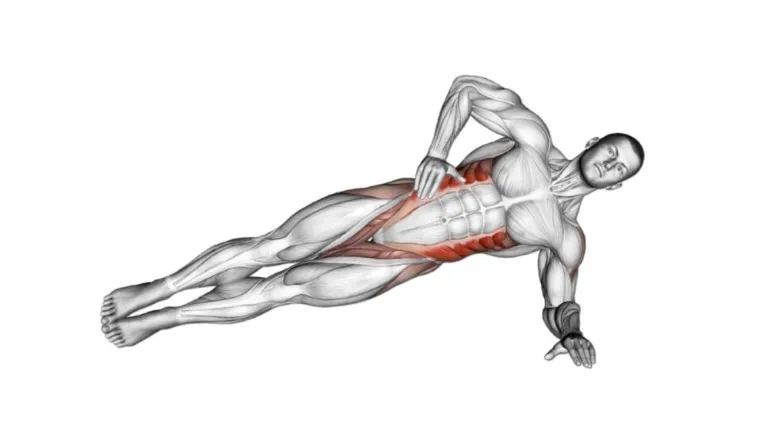
How To Do
- Lie on your side with your legs extended and feet stacked on top of each other.
- Place your lower elbow directly beneath your shoulder, forearm flat on the ground.
- Engage your core muscles, lift your hips off the ground, and align your body straight from your head to your heels.
- Keep your neck aligned with your spine, looking straight ahead or slightly upward.
- Hold the position for a specific duration, starting with 20-30 seconds and gradually increasing.
- Lower your hips back to the ground with control, and repeat on the other side.
Know More: Side Plank: Benefits, Variations, Muscles Used, Tips
5. Russian Twist
The Russian twist is a versatile core exercise that targets the obliques and deeper core muscles (also known as the transverse abdominis) and your lower back.
A more advanced way to do the Russian twist is to lift your feet off the floor and do a weighted Russian twist.
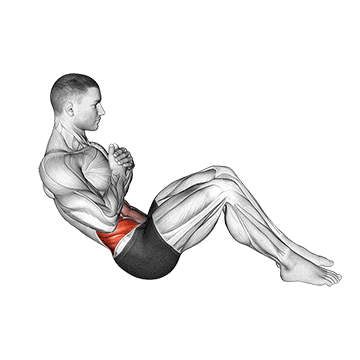
How To Do
- Sit on the floor with your hands clasped in front of your chest.
- Lean your upper body back until abs are engaged.
- Optional challenge: Lift your legs off the floor with your knees slightly bent so that your legs and torso form a V-like shape, or hold a weight or medicine ball.
- Rotate the torso to the right side so the right elbow hovers just off the mat.
- Keep the lower body still while rotating the upper body to the left side until the left elbow is just off the mat.
- Return to the center and twist to the other side.
- Repeat the twisting motion from side to side in a controlled and rhythmic manner.
6. Bicycle Crunch
In a study conducted by ACE, a comparison was conducted between the efficacy of the bicycle crunch and 12 other common abs exercises, and it was determined that the bicycle crunch proved to be the most effective.
Compared to the standard crunch, the bicycle crunch produces 148% more mean activity in the abs and 190% more mean activity in the obliques.
To make the exercise easier, lower your knees and raise the angle between your legs. To make the exercise harder, raise the angle between your legs.

How To Do
- Lie on the floor with your legs straight and lower back flat on the floor.
- Place your hands behind your head and raise your feet and upper back slightly off the floor.
- Make sure that you don’t pull your neck with your hands, else you can get a neck strain.
- Slowly start raising your knees at about a 45-degree angle.
- Go through a bicycle pedaling motion with your legs as you alternately touch your elbows to the opposite knees, twisting back and forth.
- Continue alternating the pedaling motion and twisting of the torso in a controlled and rhythmic manner.
7. Cross-Body Mountain Climber
The cross-body mountain climber is a dynamic exercise that targets the entire core, including the rectus abdominis, obliques, and hip flexors.
You can improve your balance, agility, coordination, strength, flexibility, and blood circulation with the cross-body mountain climber because it engages multiple muscle groups at once.
It’s like getting a total-body workout with just one exercise. This workout is a good addition to your home collection of oblique exercises.
To increase the intensity, perform the exercise at a faster pace or bring your knees in toward your elbows with a slight hop.
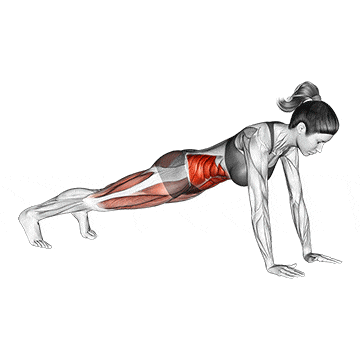
How To Do
- Start in a high plank position with your hands directly beneath your shoulders.
- Your body should form a straight line from your shoulders to your ankles.
- Squeeze your abs, lift one foot off the floor and bring your left knee towards your right elbow.
- Return to the starting position and immediately bring your right knee toward your left elbow, again crossing your body diagonally.
- Continue alternating the movement, bringing each knee toward the opposite elbow in a controlled and rhythmic manner.
8. Side Plank Hip Abduction
The side plank hip abduction is an advanced variation of the exercise you can do to target the obliques and outer thighs.
The hip abductors move the legs away from the body and rotate them at the hip joint, which plays an important role in keeping your knee and hip joints stable.
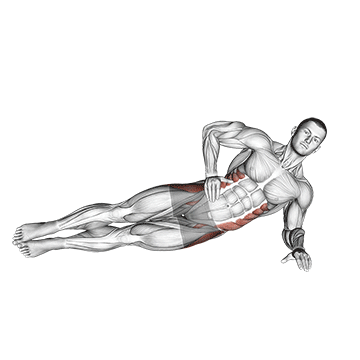
How To Do
- Lie on the floor on your left side, side with your elbow directly beneath your shoulder and legs stacked.
- Place your free hand on your hip.
- Straighten your body and legs. Your feet should be together, and your hip should be resting on the floor.
- Brace your abs and lift your hips off the floor until you’re balancing on your forearm and feet and your body forms a diagonal line.
- Lift your right leg at least 6 inches. Slowly bring your feet back together and lower your hip to the floor.
- Repeat on your right side.
9. Oblique V-Up
The oblique V-up, also known as a side jackknife crunch, is an exercise that trains both the internal and external obliques and other abdominal muscles. It is a moderate-level oblique exercise that only requires a mat.
Once you master the basic oblique V-up, you can increase the difficulty of the exercise by raising both legs off the ground.
The double side jackknife follows all the same steps as the side jackknife, except that you bring both your feet up while you raise your upper body.
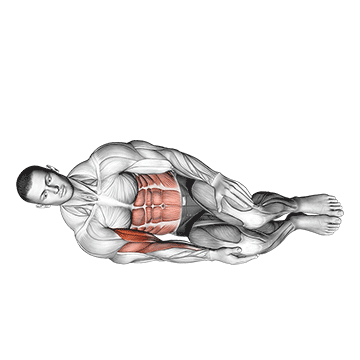
How To Do
- Lie on your left hip, legs together and right leg on top of your left.
- Place your right hand behind your head and your left elbow stays close to your body for support.
- Use your oblique muscles to raise your top leg while simultaneously raising your torso to meet it.
- Make sure you get your upper body off the floor. Don’t move just your head.
- Lower in a controlled motion and repeat, until you complete your set. Then switch sides and repeat.
10. Windshield Wipers
Floor windshield wipers are an effective and challenging exercise that targets the oblique muscles, along with the rectus abdominis and hip flexors.
The controlled rotational movements of the legs mimic the motion of the windshield wipers. This exercise also works the deep core muscles, including the transverse abdominis, which helps stabilize the spine.
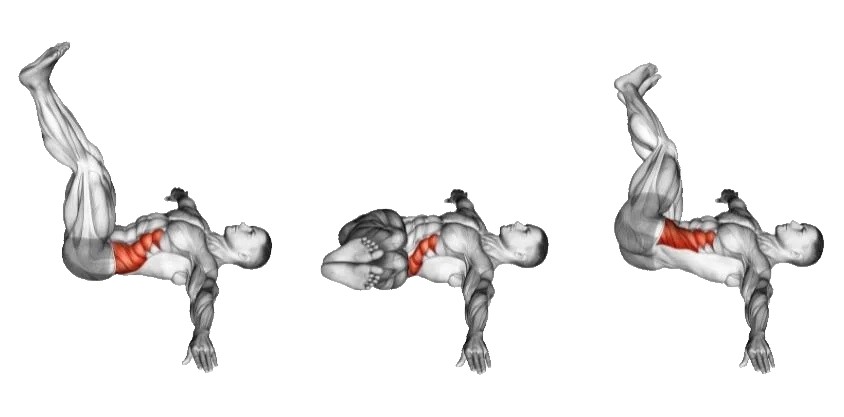
How To Do
- Lie flat on your back with your arms extended out to the sides, palms facing down, and legs straight up in the air, perpendicular to the floor.
- Engage your core by drawing your navel toward your spine.
- Start the movement by slowly lowering your legs to one side, keeping them together and as close to the ground as possible without touching each other.
- Use your oblique muscles to lift your legs back up to the starting position, and then lower them to the opposite side.
- Continue to alternate side to side with controlled and smooth motions.
FAQs
Can oblique exercises help in reducing waist size?
Oblique exercises can contribute to reducing waist size by strengthening and toning the oblique muscles. It is important to note that spot reduction is not possible. If you combine oblique exercises with cardio exercise and a balanced diet, you will lose weight and have a smaller waist.
Do planks work obliques?
Yes, planks are effective for working the obliques. Side plank variations focus on the obliques more than standard plank variations, which focus on the rectus abdominis.
Side planks engage the lateral core muscles, including the external and internal obliques, helping to strengthen and tone the sides of the abdomen.
Are obliques hard to build?
Yes, it can be challenging for some people to build obliques. Oblique muscles are often stubborn to develop, requiring consistent and targeted training along with proper nutrition. However, with dedication and the right approach, it is possible to strengthen and build the obliques over time.
Do obliques exercises thicken your waist?
No, properly developed obliques don’t necessarily make the waist thicker. Strong obliques have the potential to enhance the definition of the waistline by enhancing muscular tone and enhancing the overall shape of the midsection.
Are obliques like abs?
Yes, the obliques are part of the abs muscles. They are located on the sides of the waist and play a role in trunk rotation and lateral flexion. The obliques, along with the rectus abdominis (the six-pack) muscles, contribute to overall core strength and stability. However, the obliques have their own distinct shape and function, adding to the overall aesthetic and functional aspects of the abdominal area.
References
- Hsu, S. L., Oda, H., Shirahata, S., Watanabe, M., & Sasaki, M. (2018). Effects of core strength training on core stability. Journal of physical therapy science, 30(8), 1014–1018. https://doi.org/10.1589/jpts.30.1014
- American Council on Exercise. (2013). Core anatomy: Muscles of the core. acefitness.org/fitness-certifications/ace-answers/exam-preparation-blog/3562/core-anatomy-muscles-of-the-core/

Manish is a NASM-certified fitness and nutrition coach with over 10 years of experience in weight lifting and fat loss fitness coaching. He specializes in gym-based training and has a lot of knowledge about exercise, lifting technique, biomechanics, and more.
Through “Fit Life Regime,” he generously shares the insights he’s gained over a decade in the field. His goal is to equip others with the knowledge to start their own fitness journey.
